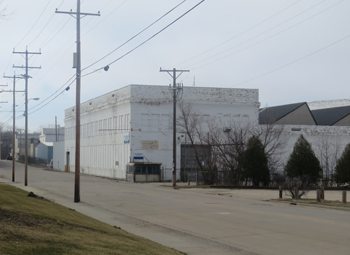Racine Mayor John Dickert keeps a large white dry erase board on an easel next to his desk at City Hall with a color-coded list of the projects he wants to get done before completing his second term.
The projects are divided into four categories: developments, water, community and housing. The projects overlap, which you can see from the arrows and lines scribbled on the board.

One of the key developments Dickert and his team have been working on for the past seven years is finally beginning to take shape: Machinery Row, a $62 million mixed-use redevelopment project along the Root River in downtown Racine that could be the catalyst the city is looking for to spark development in the blighted area.
If successful, the project could bring 150 market rate apartments, a grocery store, dining, retail, outdoor event space and a 2.5-mile riverfront promenade to 20.5 acres of land.

The Machinery Row development is the first step in Racine’s RootWorks river redevelopment plan, created by the city in 2012, to convert the neglected area of the city into a neighborhood similar to Milwaukee’s Historic Third Ward.
“I’m envisioning something that will be so hip and cool everyone will be there – like the Third Ward,” Dickert said. “But the Third Ward is the Third Ward. We’re going to create our own space. This is going to be the RootWorks area. It will have a life of its own.”
The 325-acre Root River Corridor encompasses the area adjacent to the Root River bordered by Memorial Drive on the west, State Street to the north, Lake Michigan to the east and Eighth Street to the south. The other projects targeted in the corridor include a Transit-Oriented Development District, Case New Holland’s downtown riverfront campus, the Belle Harbor District and the Walker Site Redevelopment. Those projects are in various stages of development.
Dickert, who worked in commercial real estate for seven years before being elected mayor in 2009, said what he learned in real estate was you have to juggle multiple projects at once to be successful. That is how Dickert runs the city.
“Some you win, some you lose, but you have to work them all. The reality is, if you get one in 10, you’re doing great,” Dickert said.
Now that Machinery Row is advancing, attention has been turned to the other RootWorks projects.
“We still meet on (Machinery Row) weekly, but we know they are getting started, so we’ve already moved on to 30-some other projects,” Dickert said. “It’s insane, but it’s how we work.”
One of those projects includes extending the Metra commuter train line nine miles from Kenosha to Racine. This long-discussed idea has been championed by Racine and Milwaukee Democrats for years, since the Kenosha-Racine-Milwaukee rail project was shot down by the state Legislature a decade ago.

Dickert said the city will hire a consultant within the next few weeks who will do a three-month study to determine exact costs to extend the line to Racine.
“We are the only city in Wisconsin not on the interstate system,” he said. “We’ve heard from the business community that this is a disadvantage for us. We hope once people see connecting Metra to Racine it will be a natural to move it up to Milwaukee – but first, tying us to Chicago is so important.”
Another is the CNH downtown riverfront campus, which encompasses about 30 acres of privately-owned property. CNH has made a commitment to donate the land along the Root River to the city once a redevelopment plan is in place, said Thomas Friedel, city administrator.
“Right now there is an asphalt riverwalk, but no amenities over there,” Friedel said. “Our goal is to leverage some funds and come up with a way to make things look nicer.”
The former Belle Harbor Marina is another area the city is working on, along with Racine County. The five-acre former marina site is owned by Racine County and has been filled in to create a larger riverside redevelopment site. Racine County has entertained a few development proposals for the site, but hasn’t found anything that has worked, Friedel said.
The final piece of the puzzle is the Walker Site, also known as Harborside. The parcel, located at 1129 Michigan Blvd., is a 9.6-acre piece of remediated brownfield located where the Root River meets Lake Michigan. Eventually, the city would like to see a mix of commercial, office and residential similar to Machinery Row, but at this time, nothing is happening.
“The Walker site is clean and ready to go, we just need to market it,” Friedel said. “Development begets development. I think once people see Machinery Row a little further off the ground this will start to happen. It comes down to an investment and a developer; we just need a good start.”
Racine has been working with Madison- and Milwaukee-based economic development specialists and landscape architects Vandewalle & Associates Inc. since 2012 on the RootWorks project.
Jolena Presti, principal of Vandewalle, believes this is an opportunity for Racine to reinvent itself.
“We’re talking about 325 acres downtown, on the river and on the lake,”Presti said. “As with other communities, including Milwaukee, that have taken old industrial areas and reinvented them, Racine is in line to do that as well.”
One of the key components of each of the projects will be housing, Presti said. Phase one of Machinery Row includes 150 apartments. But with approximately 5,000 people working within a two-mile radius of the developments, Presti believes it makes sense to create housing options for these employees.
“I’m very optimistic about Racine,” she said. “This is a really good project that will advance or reinvent the downtown.”
Get the latest real estate news delivered to your inbox every Wednesday. Sign up for BizTimes’ Real Estate Weekly at biztimes.com/subscribe.

